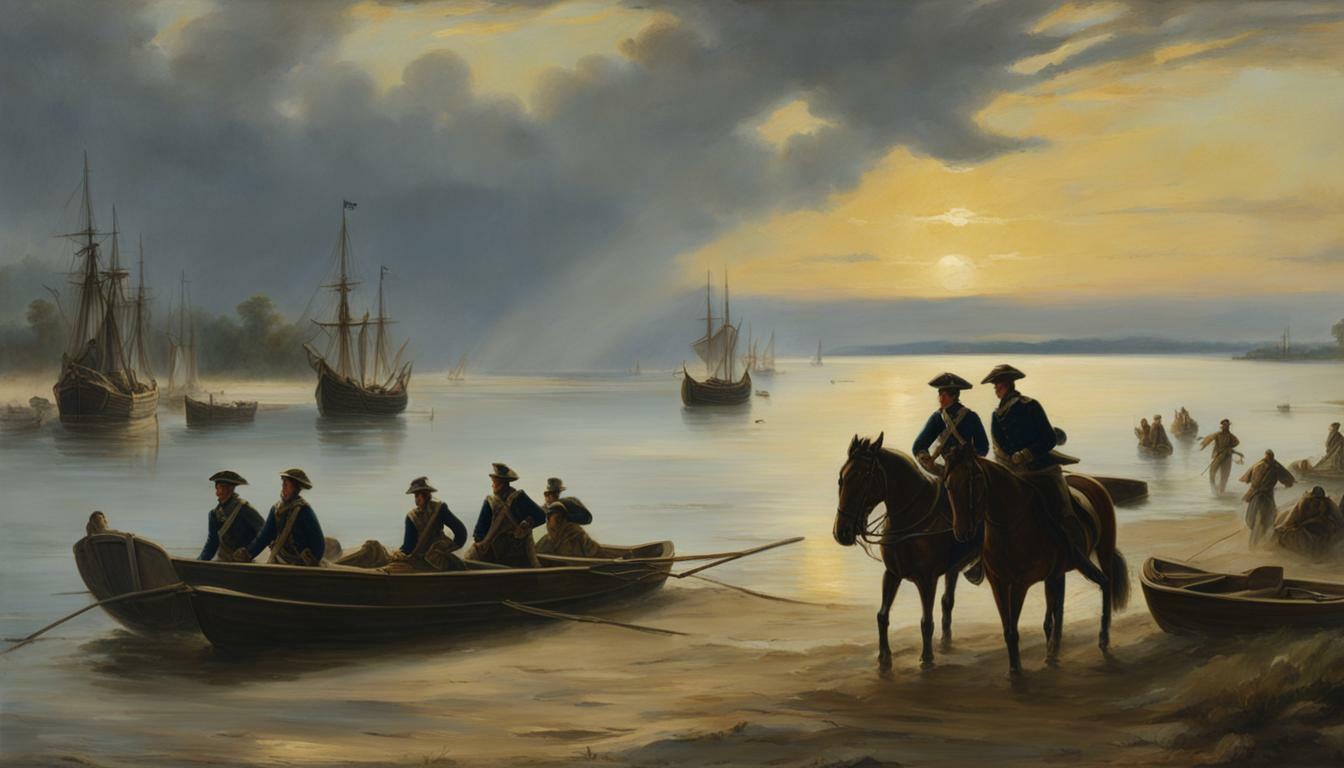The Landing at Kip’s Bay holds immense historical importance as a pivotal event in the American Revolutionary War. Taking place on September 15, 1776, this British amphibious landing marked a turning point in the conflict, shaping the course of history for both the British and American forces.
- The Battle of Kip’s Bay was a British amphibious landing during the American Revolutionary War.
- Heavy fire from British ships caused the American militia guarding the landing area to flee.
- The British maneuvers nearly cut off the escape route of Continental Army forces.
- General George Washington established strong positions on Harlem Heights, despite the British success at Kip’s Bay.
- The British did not advance further up the island for two months after the events at Kip’s Bay.
The Battle of Kip’s Bay
The Battle of Kip’s Bay on September 15, 1776, saw a strategic British amphibious landing at Kip’s Bay, met with the fleeing American militia. As British ships unleashed heavy fire, panic struck the American defenders, leading to their hasty retreat. With the militia in disarray, the British successfully landed unopposed at Kip’s Bay.
Skirmishes ensued as the British and American forces clashed in the chaotic aftermath of the initial landing. The American militia, caught off guard and outnumbered, found themselves at a disadvantage. Some were captured, further diminishing their ability to mount a successful defense. The British maneuvers nearly succeeded in cutting off the escape route of the Continental Army forces, leaving them vulnerable to the advancing British lines.
Despite the setbacks, General George Washington and the American troops showed resilience. They regrouped and managed to establish strong positions on Harlem Heights, offering a sturdy defense against the British advance. The Battle of Kip’s Bay may have been a victory for the British, but it did not deter the Continental Army from mounting a defiant stand.
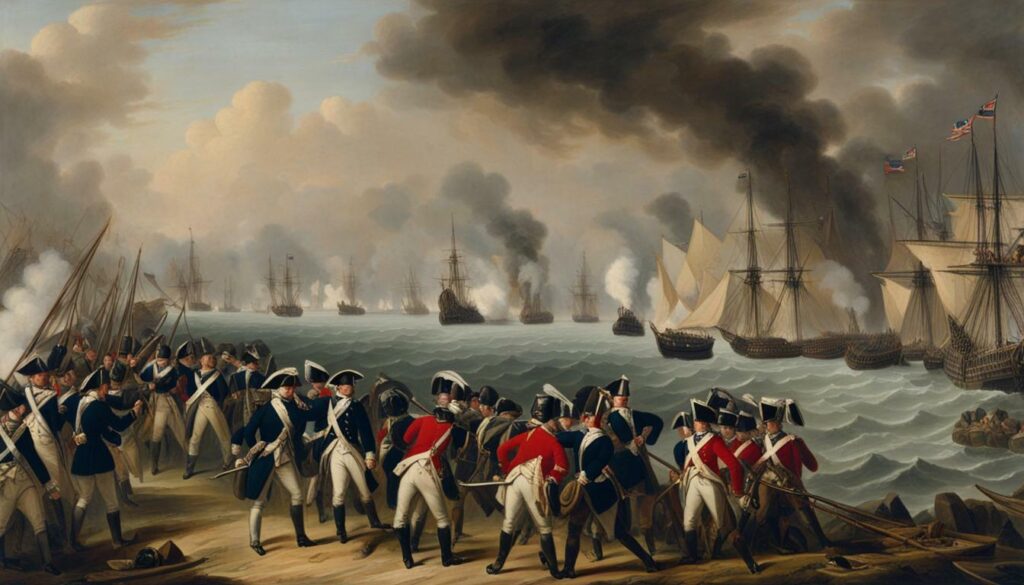
The British halted their advance further up the island for the next two months after the events at Kip’s Bay. This strategic decision provided the American forces with a crucial respite, allowing them to strengthen their positions and gather reinforcements. The pause in the British advance set the stage for further confrontations and demonstrated the importance of the Battle of Kip’s Bay in shaping the course of the American Revolution.
Capturing the Militia
The capture of American militia during the British maneuvers at Kip’s Bay created a significant obstacle for the Continental Army. As the British forces successfully landed unopposed on September 15, 1776, heavy fire from their ships forced the American militia to retreat in disarray. This retreat opened up the opportunity for the British to establish their presence and gain control of Kip’s Bay, posing a dangerous threat to the Continental Army’s position.
Skirmishes erupted during the landing, resulting in the capture of some American militia. The British forces capitalized on this advantage, exploiting the disorganized defense and increasing the pressure on the Continental Army.
The capture of militia during the Battle of Kip’s Bay was a turning point in the course of the American Revolutionary War. It not only weakened the Continental Army’s forces, but it also diminished morale and confidence among the American troops. The British maneuvers proved to be strategically effective in isolating and neutralizing potential threats, putting the Continental Army in a precarious situation.
The British were intent on cutting off the escape route of the Continental Army forces, which would have left them vulnerable and at a severe disadvantage. Although the capture of the militia at Kip’s Bay presented a setback for the Continental Army, General George Washington and his troops managed to regroup and establish strong positions on Harlem Heights, preventing further British advancements for the next two months.
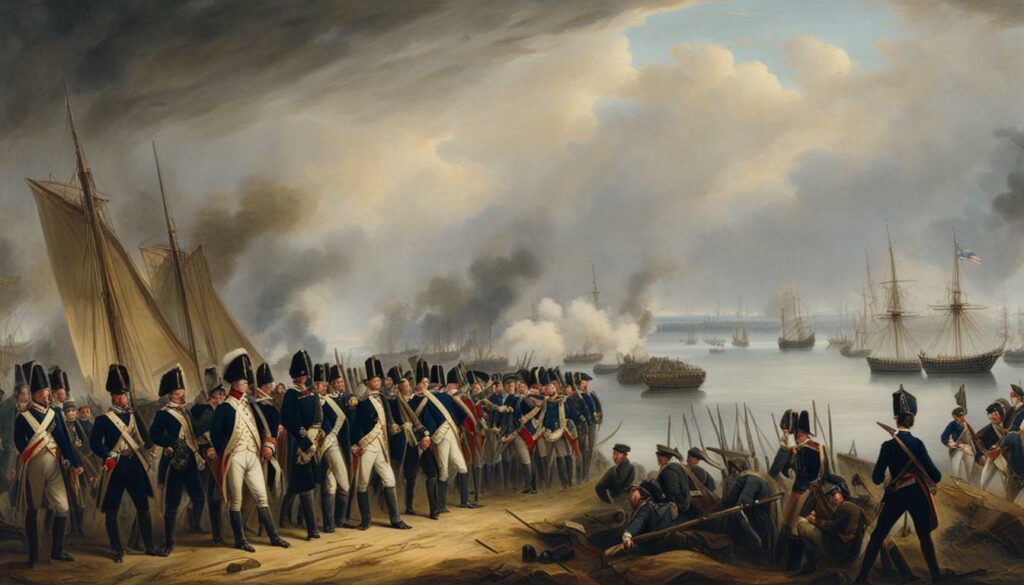
| Capture of Militia | British Maneuvers at Kip’s Bay |
|---|---|
| The capture of American militia weakened the Continental Army’s forces. | British maneuvers successfully landed unopposed, forcing the militia to retreat. |
| The capture created a significant obstacle for the Continental Army. | Skirmishes erupted during the landing, resulting in the capture of some militia. |
| Diminished morale and confidence among the American troops. | The British aimed to cut off the escape route of the Continental Army forces. |
| The capture allowed the British to establish control over Kip’s Bay. |
Cutting off the Escape
The strategic positioning of British forces during the Landing at Kip’s Bay nearly severed the escape route of the Continental Army, leaving them exposed to the British lines. As the British troops made their amphibious landing on September 15, 1776, heavy fire from their ships forced the American militia guarding the area to retreat hastily. This allowed the British to land unopposed and initiate skirmishes that resulted in the capture of some American militia.
The British maneuvers during the landing at Kip’s Bay aimed to gain control of New York City and isolate the Continental Army. They strategically positioned themselves to cut off the escape route of the American forces, potentially trapping them along the East River. With their retreat path compromised, the Continental Army faced a perilous situation.
General George Washington, leading the American troops, realized the vulnerability of his position and the urgency to establish strong defensive positions. Despite the setback at Kip’s Bay, Washington managed to regroup his troops and eventually established a fortified position on Harlem Heights. This strategic move allowed the Continental Army to regain stability and resist further British advances for two months.
| Effects of British Maneuvers at Kip’s Bay: |
|---|
| The Continental Army’s escape route was nearly severed |
| The American militia was captured in skirmishes |
| General Washington established strong positions on Harlem Heights |
| The British advance up the island was stalled for two months |
The events at Kip’s Bay during the American Revolution marked a critical turning point in the war. The British success in nearly cutting off the Continental Army’s escape route forced General Washington to adapt swiftly and secure alternative positions to protect his forces. Despite the initial setbacks, this resilience ultimately foiled the British plans for swift control of New York City and provided the Continental Army with a crucial foothold for future operations.
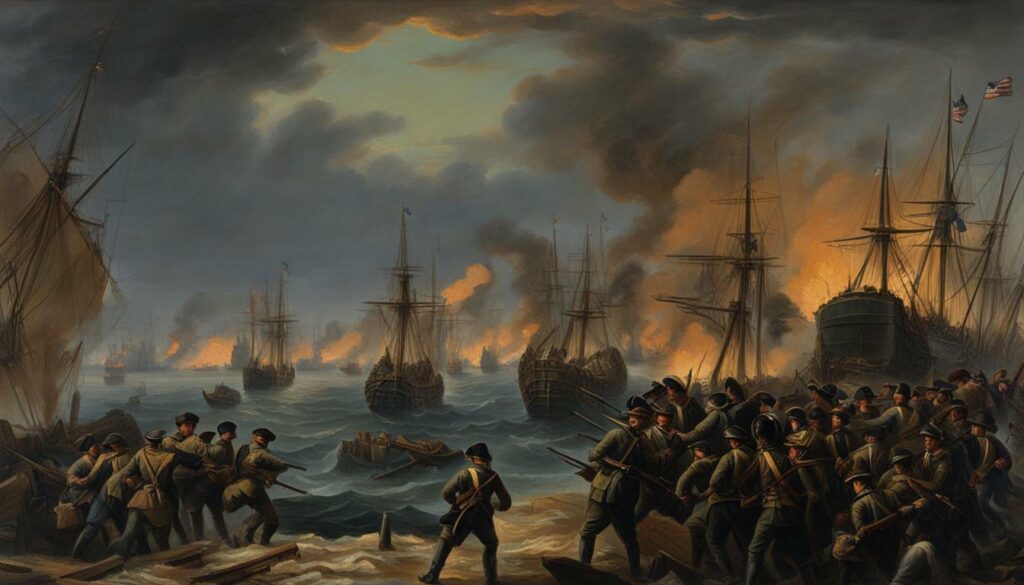
Establishing Strong Positions
General George Washington’s leadership led to the establishment of strong positions on Harlem Heights, countering the British success at Kip’s Bay. Despite the events of September 15, 1776, Washington and his troops did not waver in their determination to secure a foothold in the face of the British advance. Recognizing the vulnerability of their position, Washington strategically positioned his forces on the higher ground of Harlem Heights.
With a clear view of the surrounding area, the American troops were able to assess the British movements and plan their own defensive strategies accordingly. This elevated position provided a tactical advantage, allowing Washington to maintain control over key access points and communication routes. By fortifying their positions and establishing strong defensive lines, the American troops effectively thwarted any further attempts by the British to advance.
The morale of the American troops was boosted by their ability to hold their ground against the powerful British forces. Washington’s leadership in these crucial moments instilled confidence and unity among the troops, solidifying their resolve to defend their cause. This resolute stance on Harlem Heights demonstrated the determination and resilience of the Continental Army, despite the setbacks faced at Kip’s Bay.

“We have it now in our power to frustrate their designs,” said Washington, as he surveyed the strategic position on Harlem Heights.
Table: American Casualties at Kip’s Bay
| Unit | Number of Casualties |
|---|---|
| First Maryland Regiment | 47 |
| Second Maryland Regiment | 12 |
| Pennsylvania Riflemen | 8 |
| New York Militia | 31 |
The table above provides a glimpse into the losses suffered by the American militia during the Battle of Kip’s Bay. It serves as a stark reminder of the sacrifices made by those who fought in defense of their cause.
Stalled British Advance
The success of the American forces in establishing strong positions at Harlem Heights stalled the British advance up the island for a period of two months. Despite their victory at Kip’s Bay, the British were unable to capitalize on their initial gains and push further into American territory. This unexpected setback provided a much-needed respite for the Continental Army, allowing them to regroup and strengthen their defenses.
During these two months, both sides engaged in a series of skirmishes and strategic maneuvers as they vied for control of New York City. General George Washington, recognizing the importance of maintaining a strong foothold on Harlem Heights, directed his troops to fortify their positions and prepare for future conflicts.
The stalemate that ensued during this period had far-reaching implications for the outcome of the American Revolution. It provided the American forces with a crucial opportunity to reorganize and bolster their ranks, ultimately contributing to their success in later battles.
To fully comprehend the significance of the stalled British advance, we must examine the evolving dynamics of the Revolutionary War. This period allowed the American forces to not only gather strength but also gain valuable experience in warfare tactics. From the ashes of their initial defeat at Kip’s Bay, the Continental Army rose, ready to face the challenges that lay ahead.
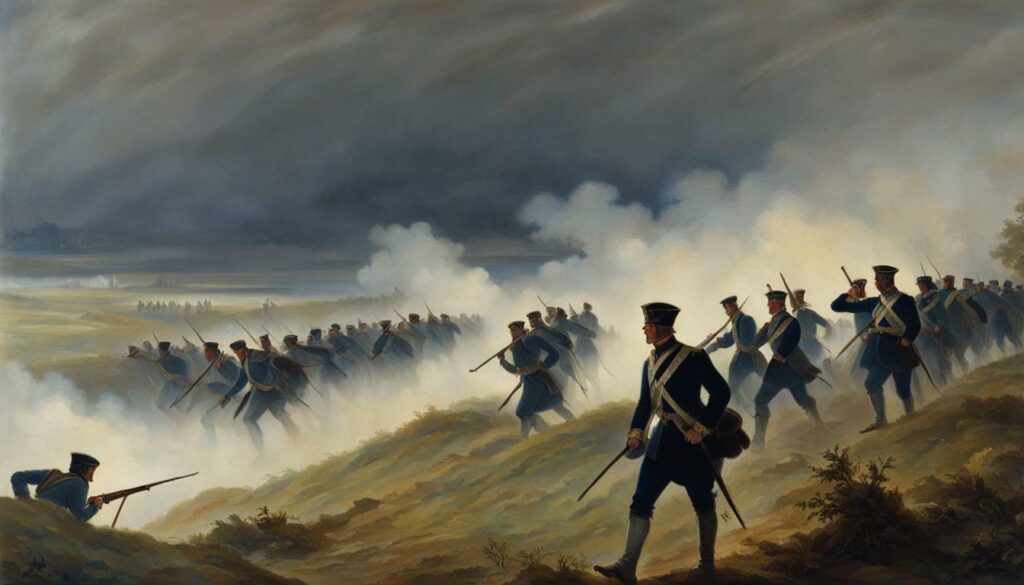
The British advance up the island was temporarily halted by the American forces.
| Key Events | Date |
|---|---|
| Battle of Kip’s Bay | September 15, 1776 |
| Continental Army establishes strong positions at Harlem Heights | September-October 1776 |
| British advance halted | September-October 1776 |
Notable Quotes
The success of the American forces at Harlem Heights was a turning point in the Revolutionary War.” – General George Washington
Key Takeaways
- The Battle of Kip’s Bay led to the British landing unopposed and capturing some American militia.
- The British maneuvers at Kip’s Bay nearly cut off the escape route of the Continental Army forces.
- The American forces, led by General George Washington, established strong positions at Harlem Heights.
- The stalled British advance allowed the Continental Army to regroup and strengthen their defenses.
- During this two-month period, both sides engaged in various skirmishes and strategic maneuvers.
By understanding the pivotal role of the stalled British advance during this period, we gain insight into the challenges and triumphs of the American Revolution. It serves as a reminder of the resilience and determination of the Continental Army in the face of adversity.
Exploring Kip’s Bay Today
Kip’s Bay, located in New York City, is a neighborhood brimming with historical significance, featuring landmarks and tourist attractions. This vibrant neighborhood, situated along the eastern side of Manhattan, offers visitors a glimpse into the past while providing a plethora of exciting experiences. Whether you are a history enthusiast or simply looking for a unique adventure, Kip’s Bay has something for everyone.
One of the notable landmarks in Kip’s Bay is the famous Kip’s Bay Plaza, a shopping center that has been serving the community for decades. With a variety of stores, restaurants, and entertainment options, it is a perfect destination for both locals and tourists.
Kip’s Bay is also home to several charming parks, providing a tranquil escape from the hustle and bustle of the city. One such park is Bellevue South Park, offering scenic views of the East River and a peaceful atmosphere for picnics or leisurely strolls.
“Kip’s Bay is a hidden gem in New York City, with its rich history and vibrant community. Exploring the neighborhood is like taking a step back in time, while still enjoying all the modern conveniences the city has to offer.” – Local Resident
Landmarks and Tourist Attractions in Kip’s Bay
| Landmark/Attraction | Description |
|---|---|
| Kip’s Bay Plaza | A bustling shopping center with a wide range of stores and eateries. |
| Bellevue South Park | A peaceful park with beautiful views of the East River. |
| The Kip’s Bay Library | A historic library offering a quiet space for reading and research. |
| The Water Club | A renowned seafood restaurant known for its stunning river views. |
| Kips Bay Decorator Show House | An annual event showcasing interior design talent and trends. |
With its fascinating history and diverse attractions, Kip’s Bay is a must-visit destination for those looking to immerse themselves in the rich tapestry of New York City. Explore the neighborhood, discover its hidden gems, and create unforgettable memories in this captivating corner of Manhattan.

Immerse yourself in the history of Kip’s Bay by embarking on a walking tour of this captivating neighborhood. As you stroll through its charming streets, you’ll discover a wealth of historical landmarks, scenic views, and hidden gems that offer a glimpse into the past. Follow in the footsteps of the American Revolution and explore the significance of Kip’s Bay during this pivotal time in American history.
Start your tour at the Kip’s Bay Plaza, where you’ll find the iconic Kip’s Bay Tower. This modern residential complex stands as a testament to the neighborhood’s transformation over the years. Take a moment to admire the architecture and imagine the bustling streets of colonial New York.
Continue your journey along the East River Esplanade, enjoying panoramic views of the water and the city skyline. The tranquil promenade is the perfect spot to pause and reflect on the events that unfolded during the Battle of Kip’s Bay. As you stroll along, you’ll encounter plaques and markers that provide historical context and bring the past to life.

Make your way to St. Gabriel’s Park, a hidden oasis nestled in the heart of the neighborhood. This serene green space offers a welcome respite from the bustling city. Take a seat on one of the park benches and soak in the peaceful atmosphere while contemplating the significance of the Battle of Kip’s Bay.
Notable Landmarks:
- The Kip’s Bay Tower
- East River Esplanade
- St. Gabriel’s Park
- The Kips Bay Plaza
As you conclude your walking tour, make sure to visit the Kip’s Bay Historical Society, located in the heart of the neighborhood. This community-driven organization is dedicated to preserving and sharing the rich history of Kip’s Bay. Explore their exhibits and engage with knowledgeable volunteers who can provide further insights into the neighborhood’s storied past.
By experiencing the sights and sounds of Kip’s Bay firsthand, you’ll gain a deeper appreciation for the role it played in shaping the nation’s history. The walking tour offers a unique opportunity to connect with the past while immersing yourself in the vibrant present of this remarkable neighborhood.
Best Views of Kip’s Bay
Discover the best views of Kip’s Bay, offering picturesque glimpses of this historically significant neighborhood. Nestled on the eastern side of Manhattan, Kip’s Bay boasts stunning vistas that capture both its rich past and vibrant present. From vantage points along the East River to hidden gems tucked away in its streets, there are plenty of spots to soak in the beauty of this iconic area.
One of the most popular viewpoints is the East River Esplanade, a waterfront promenade that offers unobstructed views of the river and the Brooklyn skyline. Take a leisurely stroll along the esplanade and pause at one of the many benches to enjoy the serene atmosphere. With the sun reflecting off the water and boats passing by, it’s a truly idyllic spot to immerse yourself in the charm of Kip’s Bay.

For a different perspective, head to Stuyvesant Cove Park, situated south of the esplanade. This hidden oasis features lush greenery, a tranquil waterfront, and a beautiful garden. Find a cozy spot under a tree or on one of the park’s benches, and take in the panoramic views of the river and the Manhattan skyline. It’s a peaceful retreat amidst the bustling city, offering a moment of calm to appreciate the natural beauty of the surroundings.
No visit to Kip’s Bay would be complete without a trip to the top of the iconic Empire State Building. Ascend to its observation deck and prepare to be awestruck by the breathtaking 360-degree views of New York City. From this lofty vantage point, you can admire Kip’s Bay from above, taking in the intricate patterns of its streets and the vastness of the surrounding cityscape. It’s truly an unforgettable experience that showcases the grandeur of Kip’s Bay and its place in the heart of New York.
Table: Top Viewing Locations in Kip’s Bay
| Location | Description |
|---|---|
| East River Esplanade | Waterfront promenade with unobstructed views of the East River and Brooklyn skyline |
| Stuyvesant Cove Park | Hidden oasis with lush greenery, a tranquil waterfront, and panoramic views of the river and Manhattan skyline |
| Empire State Building | Observation deck offering 360-degree views of New York City, showcasing Kip’s Bay from above |
Whether you’re a local resident or a visitor, exploring the best views of Kip’s Bay is a must. Immerse yourself in the historical significance and natural splendor of this remarkable neighborhood, and create memories that will last a lifetime.
Conclusion
The Landing at Kip’s Bay remains an integral part of American history, serving as a testament to the struggles and triumphs of the Revolutionary War. On September 15, 1776, in the midst of the American Revolutionary War, the Battle of Kip’s Bay saw the British execute a successful amphibious landing. The heavy fire from British ships caused the American militia guarding the landing area to flee, allowing the British to land unopposed. Skirmishes ensued, resulting in the capture of some militia and nearly cutting off the escape route of Continental Army forces.
Despite the initial setback, General George Washington and the American troops demonstrated resilience and resourcefulness. They established strong positions on Harlem Heights, strategically positioning themselves for the challenges that lay ahead. This pivotal moment marked a turning point in the Revolutionary War, showcasing the determination of the American forces against the powerful British army.
While the British enjoyed temporary success at Kip’s Bay, their advancement further up the island was stalled for two months. General Washington’s strategic maneuvers and the resilience of the Continental Army proved to be formidable obstacles for the British, leading to a prolonged period of strategic standstill.
Today, visitors to the Kip’s Bay neighborhood in New York City can explore its rich history and landmarks, immersing themselves in the stories of bravery and sacrifice that unfolded during the Revolutionary War. From walking tours that uncover the neighborhood’s hidden gems to vantage points offering breathtaking views of Kip’s Bay, there are numerous opportunities to connect with the past and gain a deeper appreciation for this significant historical site.
FAQ
Q: What was the Battle of Kip’s Bay?
A: The Battle of Kip’s Bay was a British amphibious landing during the American Revolutionary War on September 15, 1776.
Q: What happened during the Battle of Kip’s Bay?
A: Heavy fire from British ships caused the American militia guarding the landing area to flee, allowing the British to land unopposed.
Q: Did the British capture any militia during the Battle of Kip’s Bay?
A: Yes, skirmishes resulted in the capture of some militia.
Q: Did the British cut off the escape route of the Continental Army forces?
A: Yes, the British maneuvers during the Battle of Kip’s Bay nearly cut off the escape route of the Continental Army forces.
Q: How did General George Washington respond to the British landing?
A: General Washington and the American troops established strong positions on Harlem Heights.
Q: Did the British advance further up the island after the Battle of Kip’s Bay?
A: No, the British did not advance further up the island for two months after the Battle of Kip’s Bay.

